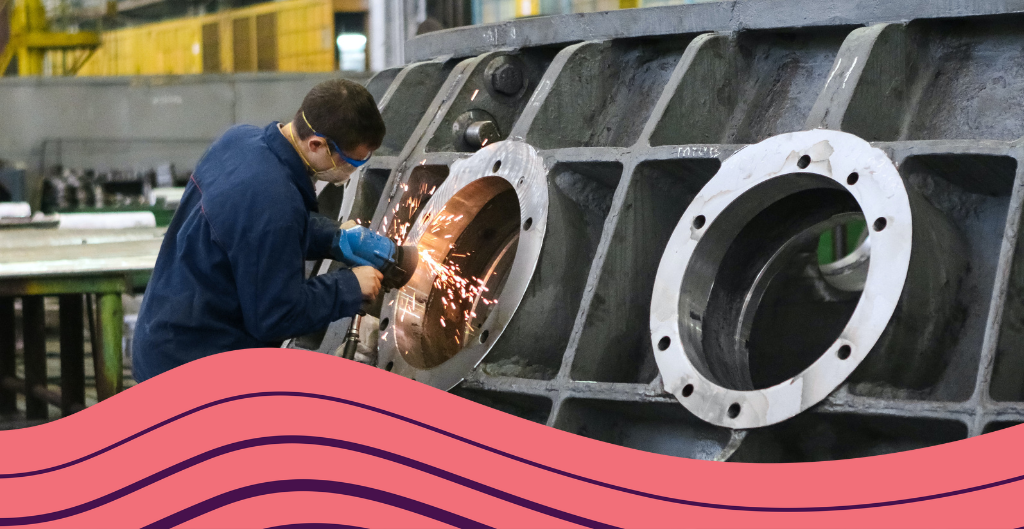The manufacturing industry’s demographic challenges are well known. According to the Bureau of Labor’s most recent statistics, Black and Latine (28.2%) and women (29.3%) workers are less well represented in the industry than in the broader workforce (31.1% and 46.8% respectively). Increasing opportunities and representation in this traditionally white and male industry will be vital to meeting the workforce needs of tomorrow’s economy.
As the National Association of Manufacturers (NAM) puts it, the industry faces a growing related workforce crisis: too many manufacturing jobs and not enough workers to fill them. According to the Manufacturing Institute, US manufacturing is expected to grapple with upward of 2.1 million unfilled jobs by 2030.
Confronting Industry Challenges: Shifting Cultures and Perspectives
Securing the future of manufacturing clearly depends on building an inclusive workplace capable of attracting and retaining diverse talent. Yet transforming the industry’s workforce will require a major culture shift involving new commitments to addressing skill and opportunity gaps. Toward this end, The National Association of Manufacturers’ Pledge for Action specifically commits to closing opportunity gaps by “taking 50,000 tangible actions to increase equity and parity for underrepresented communities, creating 300,000 pathways to job opportunities for Black people and all people of color.”
In the wake of the US Supreme Court’s recent affirmative action decision, the industry is increasingly grappling with a new challenge: the perception that DEI commitments are performative rather than sincere. Although the apparent improvement in the industry’s image problem with younger workers is cause for celebration, significant hurdles remain: 70% of surveyed Black professionals, for example, believe that their employer should do more to create a diverse, equitable, and inclusive environment, while women workers report being 1.8 times more likely to leave. In addition, a recent survey of frontline workers found that only 38% feel DEI initiatives are truly focused on creating a better workplace for all.
Seramount data suggests that manufacturing industry leaders are keenly aware of these challenges. In our research, surveyed manufacturing employers compensated for DEI results at a higher rate (60%) than the cross-industry average of 49.4%. A recent report by the Manufacturing Institute and Keybridge also found that 72% of surveyed respondents strongly or somewhat agreed that diversity is a key focus of their company.
In support of NAM’s industry-wide goal of reflecting the diversity of the broader US workforce by 2030, we’ve distilled Seramount surveys and the DEI benchmarking data we receive each year from thousands of organizations. To be sure, meeting the industry’s challenges head-on won’t be easy. But with actionable insights in hand, CDOs and talent leaders can facilitate truly transformative culture change. Toward this end, below you’ll find our top industry lessons learned across 10 key areas of concern.
1. Diversifying the Talent Pipeline
Today broadening the talent pipeline is fundamental to any successful DEI strategy in the space. For this reason, it’s unsurprising that a 2021 research report from the Manufacturing Institute identified “be an employer of choice” as the number one reason manufacturing companies pursue DEI initiatives. Industry leaders are continuously innovating new programs to capture diverse early career talent, from relaxing certification requirements and developing new apprenticeship programs to creating inclusive STEM initiatives for women and new partnerships with historically Black educational institutions.
While manufacturing leaders understand that DEI excellence provides a competitive advantage across all aspects of the talent lifecycle, Seramount surveys reveal that the industry lags in terms of recruitment accountability initiatives. With regard to gender, race, and ethnicity, surveyed manufacturing companies were less likely than their cross-industry peers to report:
- Expecting recruiters to explain why a slate lacks candidates from underrepresented groups (40% versus 63.1% in the cross-industry sample).
- Expecting hiring managers to explain why a candidate from an underrepresented group is not selected for a role (30% versus 48.9% in cross-industry broader sample).
- Requiring candidates to be interviewed by a diverse panel (30% versus 47.2% in the cross-industry sample).
Seramount survey data also reveals significant opportunities in the areas of promotions and performance management.Encouragingly, 80% of surveyed manufacturing companies select external search and recruitment partners based on their ability to provide a diverse slate of candidates, on par with our cross-industry average of 83%.However, only 20% of surveyed industry employers require diverse slates of candidates for internal promotions, significantly below the 39% average across all surveyed industries.
Seramount research also finds that the industry’s integration of DEI planning into performance management remains emergent. According to Seramount industry surveys, only 40% of manufacturing firms incorporate participation in ERGs, internal/external community initiatives, or DEI-focused education programming or events, significantly below our overall cross-industry averages. By contrast, manufacturing employers were much more likely to integrate employee satisfaction data from surveys into performance reviews (80%).
Given the importance of frontline workers in the sector, a related area of concern emerges from recent industry data demonstrating that just 39% of hourly frontline workers believe their employer takes an objective view of performance and promotion.
3. Inclusive Onboarding and Employee Experience
While companies in the sector nearly universally conduct audits of talent processes to address implicit bias in sourcing, a much lower percentage of employers audits onboarding processes to address implicit bias (44.4%). Our data supports the Manufacturing Institute’s claim that companies in the space tend to focus diversity efforts more on attraction than on retention and promotion. Creating an inclusive work culture rooted in belonging means offering all employees the chance to thrive from day one, from inclusive upskilling opportunities to chances for workers to see themselves and their communities represented on the factory floor.
Our research consistently shows that sponsorship gaps significantly impact career progression. Developing effective sponsorship programs for diverse talent can be a critical tool in your retention and advancement arsenal. According to our data, only 40% of surveyed manufacturing companies currently offer a formal sponsorship program (9.4% below the cross-industry average). Increasing this number is an urgent priority for the sector, particularly when recent surveys inform us that while 51% of Black employees have at least one mentor, only 38% have at least one sponsor, leaving them with less access to valuable direction on career paths and development opportunities.
5. Leveraging Flexible Work and ERGs
Seramount surveys show that nearly all surveyed companies in the sector conduct pay-equity analyses. Yet according to the Manufacturing Institute, the top two barriers for women in the manufacturing workplace are lack of flexibility (job sharing, split shifts, telecommuting) and lack of childcare support. In this context, Seramount’s ERG research finds significant industry challenges. While 80% of surveyed employers in the space have ERGs (Employee Resource Groups) for women (12.6% below the broader cross-industry sample), only 20% offer ERGs for working parents or caregivers (54% and 42.6%, respectively, across all industries).
Organizing and empowering inclusive ERGs involves developing a comprehensive strategy to ensure access. Recent Seramount research also has shown, for example, that including frontline workers in ERGs may be the key to workplace development and progress.
6. Advancing Metrics and Accountability
Our data reveals that 60% of surveyed manufacturing firms set absolute numeric goals in diversity representation. Even more impressively, 80% of surveyed employers have set percentage change goals in diversity representation. However, there’s additional room for improvement even in this area as shared ownership of DEI goals could be further advanced. We found that only 50% of surveyed organizations in the sector hold managers accountable for their oversight of DEI during the performance review process (21% below the broader cross-industry sample average).
7. The State of DEI Funding and Office Structure
It’s not uncommon today to hear of the challenges of a DEI “team of one.” While CDOs and talent leaders across all industries are increasingly being asked to wear several different hats, the problem is particularly acute for DEI leaders in manufacturing. Although Seramount surveys of manufacturing companies with more than 600 employees reveal a core of committed employers—with over 10 employees in their DEI office (30%)—the vast majority (60%) maintain DEI offices with only 1 to 5 employees (7.7% above the broader cross-industry sample).
In the wake of the new compliance environment resulting from the recent affirmative action decision, today’s CDOs are experiencing funding fatigue and job creep at higher levels than ever before. Yet only real, substantial DEI investments can build the cutting-edge, authentic initiatives necessary to head off critiques of merely performative DEI programming.
8. Driving Leadership Engagement
While the importance of C-suite engagement to DEI success cannot be understated, we found that only 40% of diversity councils at surveyed manufacturing firms are overseen by the CEO. Our research also shows that while industry CEOs commonly communicate support for DEI through official channels including social media (80%), employee handbooks/codes of conduct (70%), annual reports (70%), intranets/internal websites (90%), and official company websites (100%), no surveyed company in the space reported having a CEO with a personal blog on the topic, far below the 26.1% average for all companies.
Industry reports from the Manufacturing Institute and others have long emphasized the difference between acknowledging the importance of DEI to company success and commitment at the highest levels. Seramount surveys of manufacturing employers demonstrate that it’s rare for the head of DEI to report directly to the CEO. In fact, 77.8% of surveyed companies indicated that their most senior DEI executive reports to a direct report of the CEO (this occurred far less commonly at 38% across all industries, where a greater share report directly to the CEO). Personal commitment to DEI and direct engagement with key stakeholders are more important than ever before for leaders, particularly given the significant gaps between sentiment scores for manufacturing executives and workers of color in recent workplace inclusion surveys.
9. Championing Supplier Diversity
The good news: nearly all surveyed manufacturing employers expressed a commitment to supplier diversity, 90% maintain a formal supplier diversity program, and 80% select external search and recruitment partners based on their ability to provide a diverse slate of candidates. However, we also found that the responsible individual for these programs nearly always resided in procurement rather than in a DEI-facing role. In addition, our data shows that stronger vendor accountability measures such as asking for an implementation plan or withholding fees for unsatisfactory results were less commonly employed in manufacturing than in other surveyed industries.
10. The Business Value of a Comprehensive DEI Strategy
Major industry studies have repeatedly demonstrated the ROI of DEI. According to recent research by the Manufacturing Institute, 63% of surveyed manufacturers link the business benefits of DEI to an enhanced ability to attract, retain, and develop talent. A related analysis of Fortune 500 manufacturing companies similarly reveals that organizations fostering diverse and inclusive environments are more likely to have stronger financial performance.
The Manufacturers Alliance’s 2016 call for businesses to embed their diversity and inclusion strategies and tactics within their workflows still resonates today. Now more than ever, a comprehensive, data-driven DEI strategy is key to driving culture change and business success in the industry.
To learn more about how Seramount research and insights can help you stay ahead of the curve, contact us.



![1. Nicholson-Michael-06282024-1[41] michael headshot](https://seramount.com/wp-content/uploads/2023/09/1.-Nicholson-Michael-06282024-141-300x300.jpg)